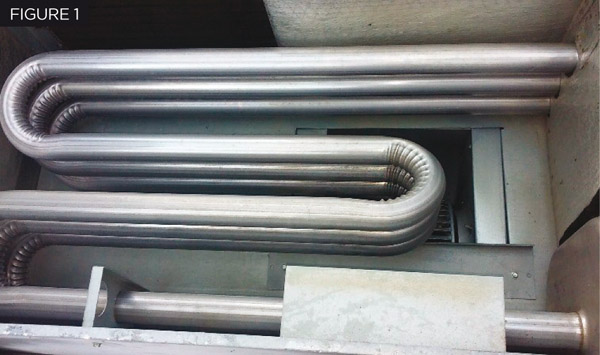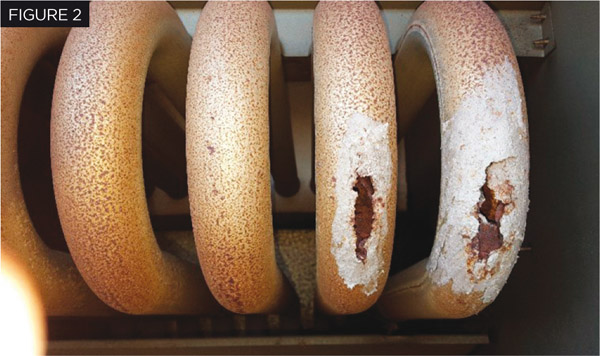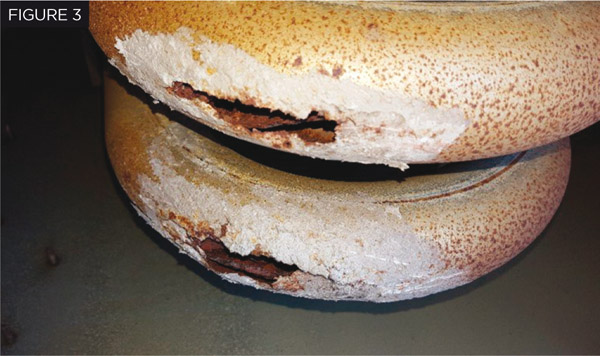It's hard to believe, but winter is just around the corner, andwith it comes a new wave of heating, ventilation andair-conditioning claims.
|A common failure that aging HVAC systems suffer in fall andwinter months is the breakdown of the heat exchanger because ofthermal fatigue.
|To some degree, all metals that are repeatedly heated and cooledare subject to thermal fatigue, a cyclic stress that weakens themetal to an eventual point of failure. The degree to which metalsare affected by thermal fatigue includes such stressors as: Howoften the metal heats and cools, how quickly the temperature of themetal changes, and the composition of the metal.
|When metal fails because of thermal fatigue, it most oftenoccurs when the metal is hot, and presents itself in the form of acrack, which grows and deepens over time.
|One HVAC component particularly susceptible to thermal fatigueis the system's heat exchanger.
|These are found in every gas- or oil-fired split system orpackaged unit application, and they provide an efficient method oftransferring the heat created by the burners to the supply air,while segregating the combustion gasses from the air itself.
|As seen in Figure 1, the typical heatexchanger comprises several metal tubes wrapped in a serpentinefashion that are connected on one end with the system's burners andcombustion chamber, and on the other end to a vent or exhaust flue.As the supply air is pushed by the blower across the heat exchangertubes, the heat transfers away from the heat exchanger to thepassing air, following the second law of thermodynamics.
|
In HVAC heat exchangers, thermal fatigue is accelerated by thecorrosive combustion gasses that pass through the heat exchangertubes on their way to the exhaust flue and by condensation that maycollect in the heat exchanger during heat transfer.
|Heat exchanger cracks can range in size from small, almostimperceptible fissures, to gaps wider than a half inch or more. Andwhen heat exchangers do crack, the failure not only results inincreased claim settlement amounts (because of the costly effect ofthe failure), but may also introduce toxic gasses into theinsured's supply air.
|Continue reading ...
||
Such was the case with one commercial rooftop packaged unitinstalled in 1986, which suffered heat exchanger failure because ofa lack of routine system maintenance and age-related wear and tear(see Figures2 and 3).
|In this case, the elbows of the heat exchanger tubes had beensubjected to a combination of moisture, corrosion and repeatedheating and cooling, and thus began to rust and deteriorate overtime.
|The tubes ultimately failed at this elbow location (a commonfailure position found during field inspections), and the air beingsupplied to the commercial building was contaminated by the exhaustfumes.
|
Unfortunately, the heat exchanger crack was not immediatelydiscovered by the insured, exposing unwitting tenants with a steadysupply of toxic air.
|Only after repeated flame rollouts (which were attributed to thepressure changes caused by the holes in the heat exchanger tubes)melted the system's control wiring — which led to total systemfailure — was the true scope and effect of the failurerecognized.
|The insured was fortunate, in fact, that the flame rollout dideventually cause the system to fail. Had the system controls notbeen destroyed, the supply air would have continued to be pollutedwith toxic fumes. These toxic fumes could have included carbonmonoxide, which can cause illness or even death.
|Because of the age of the HVAC system, a replacement heatexchanger was not available for purchase from the manufacturer orfrom local distributors. Thus, full system replacement was requiredto restore the insured to pre-loss condition.
|In many cases, even if a compatible heat exchanger is available,the cost of materials and labor required to disassemble andreassemble the system to execute the repair would nevertheless leadto a recommendation to replace a split system or packaged unit inits entirety.
|Eventually, all HVAC heat exchangers succumb to thermal fatigue.How quickly they fail depends on how often they’re used, and howwell they are maintained. And regardless of coverage, the effect ofthis failure on HVAC claim settlements makes this topic criticalfor adjusters to understand and appreciate, as it very oftenresults in a significant and costly restoration.
|Matt Livingston is the director of customer education forCharlotte, North Carolina-based HVAC Investigators, which providesassessments of HVAC and refrigeration claims for insurancecarriers.
|Related: 4 options to consider when adjusting HVAC hailclaims
Want to continue reading?
Become a Free PropertyCasualty360 Digital Reader
Your access to unlimited PropertyCasualty360 content isn’t changing.
Once you are an ALM digital member, you’ll receive:
- All PropertyCasualty360.com news coverage, best practices, and in-depth analysis.
- Educational webcasts, resources from industry leaders, and informative newsletters.
- Other award-winning websites including BenefitsPRO.com and ThinkAdvisor.com.
Already have an account? Sign In
© 2024 ALM Global, LLC, All Rights Reserved. Request academic re-use from www.copyright.com. All other uses, submit a request to [email protected]. For more information visit Asset & Logo Licensing.








